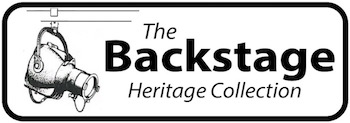
Light Palette (1978 - 1988)
Strand

Light Palette
Strand Century product
1978: 256 max channels, 512 dimmers, 200 cues memorised
First used on Beatlemania, lit by Jules Fisher
1980: 1000 channels with 8 submasters.
This desk was the first use of VDUs in lighting control (by Strand).
The final version, known as V6E, was discontinued in April 1988.
Selected Installations:
Manchester Palace Theatre, 240 ways
Edinburgh Playhouse, 182 dimmers (later updated to V6E software), still in use in 1999?
Article from Strandlight (Vol 1, Issue 5) Autumn 1987
The Three Hundredth Milestone
A brief Light Palette Historial Resume
by Anne Morris, Control Product Manager, Strand Lighting, North America
SCENE 1
In the mid 70's, much of the lighting on the Broadway stage was controlled by massive, manually operated control consoles, which often required multiple operators and a great deal of space. Installation and labour costs for these systems were high. Designer's were artistically restricted by the complexity of manual operation.
Computerized lighting equipment was beginning to see acceptance in such consoles as Micro-Q and Multi-Q, which proved that the use of this technology expanded the scope of design ability, but did not detractf rom the "human element" of performance, which had been a great concern. The facilities of these consoles. however. were quickly outstripped by a demand for even more!
Strand/US made a commitment to Broadway - a commitment to provide new equipment offering more cost effective operation. even more design flexibility and greater artistic control. Using newly developed microprocessor technology, LIGHT PALETTE was introduced in 1978. Technical theatre had become "state of the art". This console not only provided a new method of controlling light, but launched an entire philosophy of control - a philosophy which is now the US industry standard.
LIGHT PALETTE design was based around the piano board approach to lighting control; it implemented a "Command Line" control technique in which most instructions were entered digitally in a sentence format. The console controlled 512 dimmers on 256 control channels. It allowed simplicity and centralized control, yet offered unique and sophisticated features.
Some of these features have become so standard in console design today, that they seem old hat to us. But at the time, such concepts as 6 simultaneously activated cue parts, "group" recording, electronic patching and computerized cue sheets were considered revolutionary.
The first LIGHT PALETTE was installed at the Goodspeed Opera House in East Haddam, Connecticut. LIGHT PALETTE's Broadway premier occurred during one of the strongest seasons for drama ever-with such shows as 'A Chorus Line', 'Ain't Misbehavin',' 'Annie' 'Deathtrap' and 'Da' enjoying first runs. During the next few years, the features of the console were continually expanded. Proportional patch, full tracking backup, colour monitors, and a number of other facilities were added.
SCENE 2
Due to increasing sophistication in the theatre and TV sectors, it became apparent that two separate types of software were required to address the demands of both. LIGHT PALETTE II was introduced in 1984, offering control of 1536 dimmers on 800 control channels. The theatre version of the console provided 6 playback faders, 9 submasters and was a ''Tracking" board. The TV version offered 2 playback faders. 13 submasters and provided "Cue-Only" operation. Numerous other features were added, including an alpha numeric keypad.
The "Command Line" control philosophy became so successful, that LIGHT PALETTE also became the parent of a group of smaller consoles. including MINI PALETTE, MINI LIGHT PALETTE, and MINI LIGHT PALETTE 2.
SCENE 3
Nine years and 300 LP's after its launch, we introduced the third generation LIGHT PALETTE. LP/3 offers unparalleled features, answering the needs of an increasingly demanding and sophisticated market. It brings together the needs for theatre and television in one console, by offering unique facilities which allow the operator to select the number of playback faders versus submasters. The operator may also select the recording mode, "TRACK" or "CUE ONLY". LP/3 also supports easily defined automatic system default parameters, such as default fade times, default profile, and default "Set" level.
We introduced Light Palette with the phrase 'Painting with Light' - and we believe we have enabled our customers to really live up to the slogan!
Related Venues:
- His Majestys Theatre, Aberdeen
- The Old Vic, London
- Phoenix Theatre
- Manchester Palace Theatre
- Empire Theatre, Liverpool
- Edinburgh Playhouse
- Palace Theatre, London
Related Shows
Related People:
See also:
- Pro Palette (1988 July - 1990 September)
- Mini Light Palette (1984)
- Mini Light Palette 2 / MLP2 (1987)
- Light Palette 2 (1984)
- Light Palette 3 (1987)
- MiniPalette (1980)
Documents

LSI: Classic Gear - Light Palette (November 2010)
[External Website]
From Lighting & Sound International
Exhibits in the Backstage Heritage Collection
Catalogue & Journal Entries for Light Palette in the Backstage Heritage Collection
Back to Control - Memory (Strand)
4448













